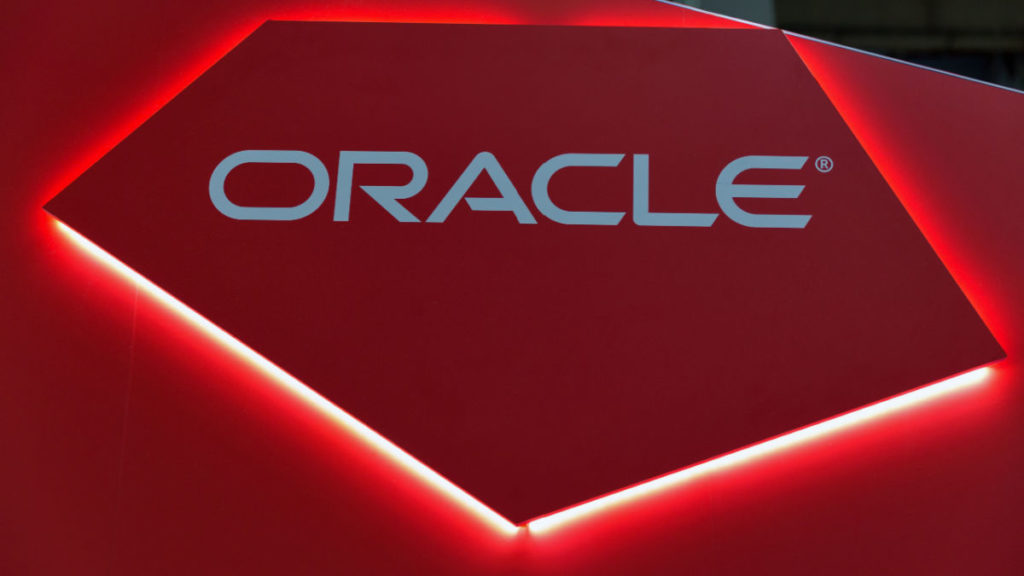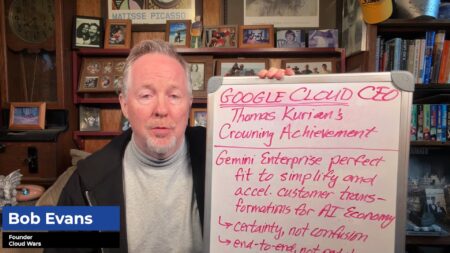
On the heels of Oracle’s dazzling 45% cloud-revenue growth rate last quarter, I’m predicting that Oracle later today will report that its red-hot cloud business remained in hypergrowth for the three months ended Nov. 30 with a growth rate of 42%.
I’m forecasting that slight decline from 45% to 42% because the uncertain global economic environment has already moderated the growth arcs of most major cloud providers. And with Oracle now the fastest-growing company among the Cloud Wars Top 10, that blistering 45% pace will be very difficult to maintain.
But when Oracle releases its fiscal-Q2 numbers later this afternoon, I would not be shocked to find that Larry Ellison and Safra Catz and their teams have exceeded my 42% outlook because Oracle’s entire cloud business — LOB (line of business) applications, industry apps, databases, and infrastructure—has been on a tear. Look at these fiscal-Q1 numbers from three months ago:
- total cloud revenue for the quarter was up 45% to $3.6 billion;
- of that, Oracle Cloud Infrastructure was $900 million, up 52% (58% in constant currency);
- total software-as-a-service (SaaS) revenue was $2.7 billion, up 43% (48% in constant currency);
- within that SaaS total, Fusion ERP Cloud revenue was up 33% (38% in constant currency); and
- NetSuite ERP Cloud revenue was up 27% (30% in constant currency).
(For more analysis on those numbers and what’s behind them, please see “Larry Ellison’s Revenge: Oracle World’s Hottest Major Cloud Vendor.”)
The wild card in Oracle’s cloud business is that infrastructure segment, called OCI (Oracle Cloud Infrastructure). While much smaller than the infrastructure businesses of the other big hyperscalers— Amazon, Google, and Microsoft — OCI has quietly won 18,000 customers, including some who surely took long, hard looks at those better-known competitors before choosing Oracle.
Those customers picked Oracle because it provided:
- superior performance for their business needs;
- lower costs than competitors;
- better interoperation with Oracle SaaS apps;
- the opportunity to move huge Oracle Database workloads to Oracle’s cloud-native Autonomous Database;
- the best (only?) way to run Oracle’s huge and fast-growing portfolio of industry-cloud apps; and/or
- some combination of all of the above.
Plus, the Cerner acquisition, which was completed mid-year, gives Oracle access to a huge new cohort of customers that will likely be at least interested in hearing about how OCI can help them run Cerner applications — plus related Oracle applications — at much higher levels of performance and security.
Also — and perhaps this should be considered the wild wild card — we should not forget that on last quarter’s earnings call, Ellison dropped some titillating hints about imminent defections of major globals from Amazon to Oracle, noting that some of the customer names of these future cloud-jumpers “will shock you.”
Here’s the relevant excerpt from my Sept. 14 analysis of Oracle’s Q1 results:
“Safra addressed the issue of modernizing the back office to save money. Let me tell you another way you can save money. I personally have been talking to some of Amazon’s most famous brands that are running at AWS,” Ellison said.
“And their AWS bills are getting very large. So, they can save a huge amount of money by moving to OCI. And I expect next quarter we’ll be announcing some brands, some companies moving off of Amazon to OCI that will shock you. I’ll stop there.”
Now, in classic Ellisonian form, he did not, of course, “stop there” but offered this follow-up later in the call: “The amount of money these huge companies, these very famous companies, spend with Amazon is kind of staggering,” Ellison said.
“Everyone assumes that if I move to the cloud, I save a lot of money. Well, that depends on which cloud you move to. And Oracle is much less expensive than the competition, partially because we’re faster — and time is money when you’re paying by the hour.
“So, again, I’m going to repeat here. We’re talking to the most famous brands that are running at Amazon and some of them are going to be moving.
“Very soon.”
Now, Larry Ellison knows a thing or two about marketing and about psychology and about momentum and about competitive positioning. So do his hints from three months ago about shocking defections to be revealed on today’s earnings call mean we should expect a long and detailed list later this afternoon?
No, I don’t think so. But I do think there’ll be at least two and perhaps three juicy names, and with the disclosure of those, Ellison will have made his point: Why would these well-known companies that have been AWS customers pull up stakes from the cloud-infrastructure category king and move to relative newcomer Oracle?
Why indeed. Because in the Cloud Wars, the savage competition guarantees that the big winners are always the customers.
To see more Cloud Wars content, including all recorded sessions from June’s live Cloud Wars Expo, please register here for your Cloud Wars Expo on-demand pass. The on-demand pass, which is included with your Acceleration Economy subscription, gives you access to approximately 40 hours of invaluable educational content.









